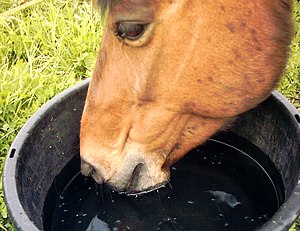 Seems like a handful of things are inevitable…death, taxes and drought. Drought? Yep, drought…if you haven’t been through a drought (and which of us haven’t?), you will. As a pond owner and steward of your water, understanding what happens in drought conditions with a pond helps us understand how to cope with it.
Seems like a handful of things are inevitable…death, taxes and drought. Drought? Yep, drought…if you haven’t been through a drought (and which of us haven’t?), you will. As a pond owner and steward of your water, understanding what happens in drought conditions with a pond helps us understand how to cope with it.
When someone asks me, “How deep should my pond be?” I always think about drought. Always. A pond needs to be deep enough that it doesn’t go dry during a drought. In areas normally subject to regular high annual average amounts of rainfall, ponds don’t need to be quite as deep. In eastern Texas and Louisiana, for example, those good folks can expect 45-55 inches of rain yearly. Coupled with average annual evaporation rates of 40-50 inches per year, theoretically, a pond only needs to be as deep as six or eight feet. But, travel a couple hundred miles west, beyond Abilene, Texas, and the equation changes. Out there, 20-24 inches is more normal, on top of 88-90+ inches of average evaporation over a year. So, a pond in that part of the world is better suited to being 15, maybe 20 feet deep, just to maintain storage capacity so the pond won’t go dry during the hottest seasons.
Here your pond sits, perched somewhere in an area destined for drought. What impacts might drought have on your favorite body of water?
There are several facts about water that we all need to understand.
- Water always moves…always. It can’t sit still. Gravity takes it, it percolates through soils, moves laterally, leaves through the bladders of animals or disappears upwardly, through evaporation. We don’t keep it, we borrow it. Understand this and you can understand your roles as a steward.
- Water is the universal solvent. Anything that can dissolve into water, will. Minerals, metals, nutrients, the atmosphere, old cars, cardboard…lots and lots of stuff dissolves into water. That’s important to know, especially in the throes of a drought.
- Water is necessary for multitudes of reasons, but remember it is a stable compound. Water comes, water goes. It’s what’s dissolved into that precious substance that can leave us shaking our proverbial heads.
- Water is harmonious in its environment. When water needs oxygen, its absorbs the gas from the atmosphere…so long it can contact the atmosphere. As a balance, water returns the favor to the air…dry air is a sponge, absorbing water as needed. Remember, water works in a continual balancing act in its natural cycle of cleansing and re-distribution. Physics play a role.
With an understanding of the facts, what do you, dear pondmeister, will help you understand the meaning of “drought” for your pond.
As your precious pond is sucked down during torrid heat and not enough rainfall, here’s what happens. There are biological effects, physical changes and chemical consequences.
The fishery will change. It has to. For most ponds, the top three or four feet constitute about half the volume of the pond. As the water draws down, fish slowly become congregated. Big fish eat smaller fish, especially where largemouth bass live. It’s Nature’s way. What’s happening, biologically, is that as the volume and size of the pond diminishes, the fishery tries to adjust. As long as there are fish which can eat other fish, the population makes those necessary adjustments. When full, a ten acre lake supports whatever that ten acre lake can support. But, when that lake shrinks to four acres during a drought, the fishery adjusts to what a four acre lake can support. Some of the fastest growing fish a biologist often sees happen to grow as a pond shrinks. Baitfish are flushed away from their safe havens around the shoreline and often end up as morsels trying to make their way in a shrinking environment.
That new bare ground which used to be pond bottom makes some changes, too. Aquatic plants lose their foothold and terrestrial plants take advantage of the opportunity. Depending the length of the drought, these former-pond-bottom soils respond accordingly. When this dirt is exposed to air and heat, it cleanses itself by composting organic matter accumulated under water. For composting to occur, oxygen must be present. In essence, the soil goes through something of a cleansing, setting itself up for a fresh new start when flooded again.
Speaking of flooded…it will rain again. Trust us on that. It won’t necessarily rain when we want it, but it will rain again. When your four acre drought-induced lake blossoms back into the ten acre lake you remember, changes will occur…again. Refreshed soils now have plant life that grew during the drought. That stuff becomes habitat for fish. Your adjusted four acre fishery now has new opportunities in its “new” ten acre environment. With fresh water and newly inundated habitat, your fish will respond by spawning. They’ll want to fill this new environment with lots and lots of new inhabitants. This move creates the opportunity for a new food chain. Existing predator fish will have new opportunities to grow rapidly…again because they have much more food and plenty of space. All this is, like Martha Stewart might say, is “A good thing”.
What about water quality during a drought? As water evaporates, all that leaves is pure water. Everything dissolved in it stays behind. To understand simply, hear this. Let’s say you have your water tested and the lab results show alkalinity in terms of calcium carbonate is 150 parts per million. CaCO3 is limestone. That’s one of the most common minerals dissolved in water. The drought ensues, your pond level drops and half the water is gone over a period of months. With half the water gone, the alkalinity doubles from 150 ppm to 300 ppm. Over those months, your fishery adjusts to this slow change. Keep in mind, in this example, we’re only talking about one parameter. In your pond, many different compounds are dissolved. You have nitrogen, probably some phosphorus, some salts, some organic matter, different minerals and metals, based on what lies in the soils beneath and surrounding your pond. As the water makes its droughty exodus, these other hangers-on stay behind. Meaning? Your water quality changes. As the quality of the remaining wet stuff changes, nature makes other adjustments. When it rains, if you get lots of rain quickly, those different chemical parameters can drastically change…sometimes within hours. All those concentration changes can be drastic enough to stress…or kill…your fish. Monthly or quarterly water chemistry analyses could be a wise move during drought.
Here’s another important rule of thumb of nature. She won’t let nutrients go unused. Where there’s food, something will grow. In most pond cases, that growth ends up being plankton. That might be a good thing, might not. Pay attention to the visibility depth of your plankton bloom. Too much bloom spoils the fun with a fish kill. Remember, hot water and dense bloom are ingredients for fish to die. As your pond recedes, the nutrients stay behind and often become more concentrated. Watching your water change color and seeing the visibility depth change is part of your due diligence.
Are there many answers, short of a daily rain dance, during drought? Yes, there are. Move the water. Aeration allows water to continue its dynamic changes, moment by moment. Seek help from someone who knows more about aeration than you do. Don’t just go online, buy a system, toss it in and turn it on. Learn first, act next. Pay attention to the water chemistry, too. Have a lab check it, compare your results. It might look like Greek at first, but the more you study, the more sense it makes. Watch the plant life. Too much of a good thing is a bad thing…especially when looking at rooted plants or mid-summer plankton blooms. If the drought persists beyond “ordinary”, consider harvesting some of your precious fish. They’ll better if you fillet them BEFORE they float up.
Here’s the bottom line. Droughts happen. There’s a drought somewhere on the planet every minute of every day. Be aware, learn about what happens during that spate of time and be prepared to react. That’s the part of stewardship that pays dividends.
Author: Bob Lusk, Pond Boss
 Do you equate a good herd-health program only with a vaccination and/or deworming program? While these are important, they aren’t the only considerations, says Christine B. Navarre, Extension Veterinarian, with Louisiana State university.
Do you equate a good herd-health program only with a vaccination and/or deworming program? While these are important, they aren’t the only considerations, says Christine B. Navarre, Extension Veterinarian, with Louisiana State university.









